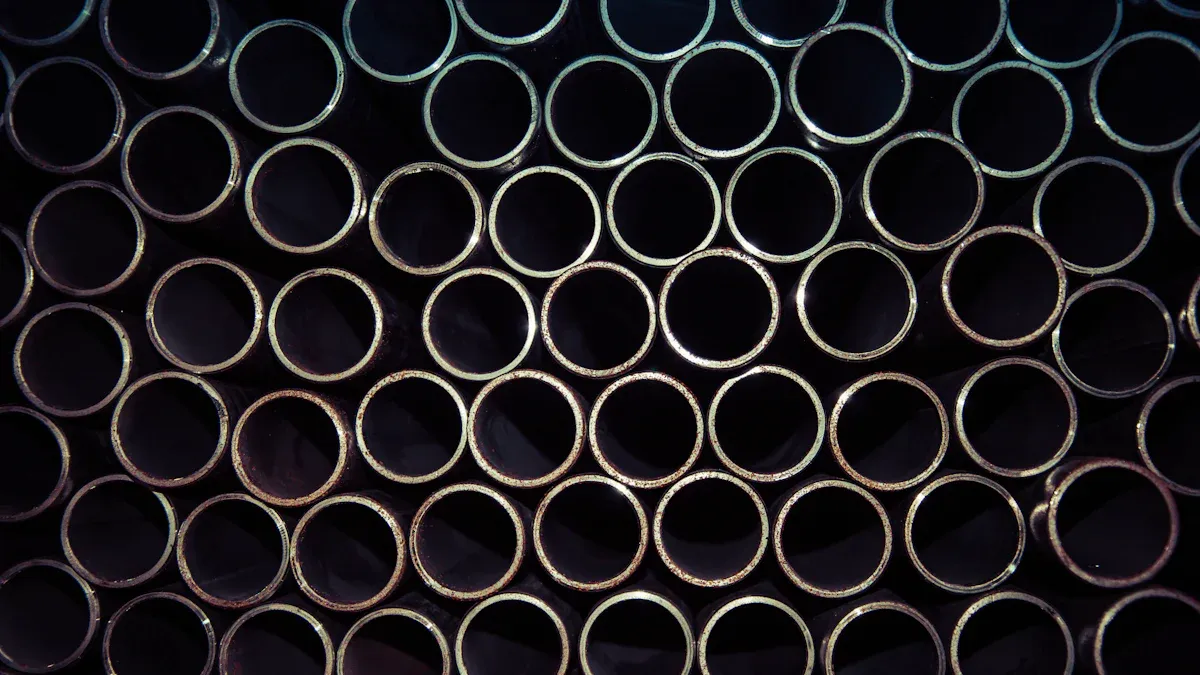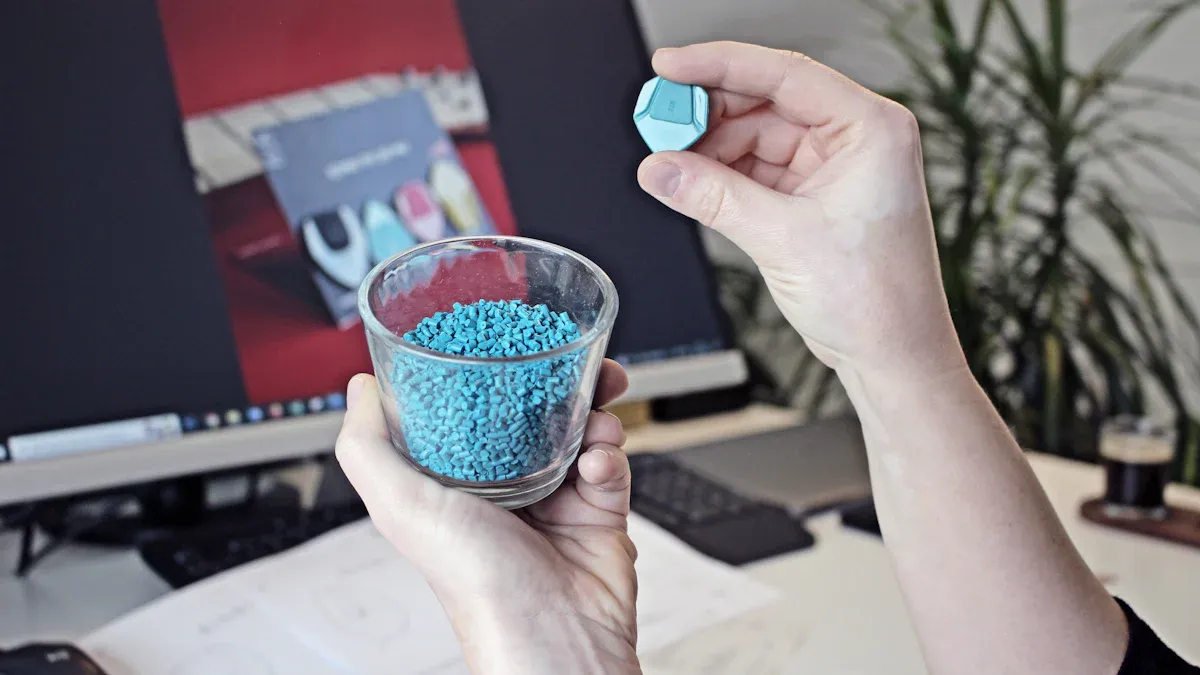3 Key Processes Behind NiTi Shape Memory Effect

NiTi shape memory effect metals can return to their original shape. This occurs under specific conditions. This remarkable ability is due to a process known as martensitic transformation, which enables the metal to "remember" its original shape. The composition of materials in NiTi is crucial, as it influences factors such as shape-change temperatures and flexibility. Researchers have even developed models to predict how the NiTi shape memory effect metal will behave.
The NiTi shape memory effect operates through three main steps: mixing and melting the metals, shaping and treating the metal, and heating it to alter its phases. Each of these steps enhances the metal's memory and functionality. Without these processes, NiTi would not exhibit its extraordinary capabilities.
Key Takeaways
NiTi alloys can go back to their original shape. This happens because of a process called martensitic transformation. It is important for use in medicine and robotics.
The mix of nickel and titanium in NiTi alloys matters a lot. Even a tiny change in nickel can change how the alloy works, like its transformation temperature.
New ways to make NiTi parts, like Laser Powder Bed Fusion (LPBF), help create detailed and strong pieces. This makes them better for use in complex machines.
Thermomechanical treatment makes NiTi alloys stronger and more flexible. This helps the material handle stress and keep its shape memory.
Heat treatment changes the temperatures when NiTi transforms its phases. This makes it useful for many things, like medical tools and airplane parts.
Alloy Composition and Melting Techniques

How NiTi composition affects its shape memory ability
The mix of nickel and titanium in NiTi alloys is very important. It controls their special features, like the shape memory effect. Even a tiny nickel change can make a big difference. For example, just 1% more nickel can change the transformation temperature by 100 K. This shows why making the right mix is so important. Scientists use smart computer models to study how different mixes work. These models check data from many NiTi alloys. They help improve the material for things like medical tools and airplane parts.
Evidence Type | Description |
|---|---|
Transformation Behavior | Nickel changes transformation temperature by 100 K per 1% change. |
Mechanical Properties | Shape recovery strains of 4.16% and superelastic strains of 7% possible. |
Process Parameters | Nickel evaporation changes titanium levels and transformation temperatures. |
Making NiTi with vacuum melting and casting
Vacuum melting and casting are common ways to make NiTi alloys. These methods keep the material clean by stopping oxygen and carbon from mixing in. But they can also cause small flaws that weaken the metal. Still, vacuum melting has benefits like better mixing and shorter heat treatment times. For instance, vacuum induction melting (VIM) makes high-quality alloys and works well with metals that melt at high temperatures. This is why it’s often used for NiTi alloys.
Metric/Measurement | VIM Advantages | AM Limitations |
|---|---|---|
Homogeneity | Better mixing in less time | Needs remelting for better mixing |
Heat Treatment Time | Shorter heat treatment | Longer heat treatment needed |
Initial Quality | High quality with simple pre-alloys | Limited by sample size and extra remelting steps |
Alloy Composition Sensitivity | Works well with high-melting-point metals | Limited by uneven material mixing |
New additive manufacturing methods (like LPBF and WAAM)
New ways to make NiTi, like Laser Powder Bed Fusion (LPBF) and Wire Arc Additive Manufacturing (WAAM), are changing the game. LPBF is great for making small, detailed parts with strong properties like superelasticity. WAAM, on the other hand, is better for bigger pieces but needs extra work to make them precise. LPBF can create tiny NiTi parts as small as 52 μm with smooth surfaces under 2 μm. These new methods are perfect for making complex items like medical devices and robots.
Method | Advantages | Disadvantages |
|---|---|---|
LPBF | Makes detailed parts with strong shape memory and superelasticity | Needs special machine settings; still being improved |
WAAM | Good for large structures | Not as detailed; needs extra work to finish |
Thermomechanical Treatment
How thermomechanical treatment improves NiTi properties
Thermomechanical treatment helps make NiTi alloys better. It mixes heat and pressure to change the alloy's structure. This makes the material stronger and improves its memory. The process also helps the alloy return to its shape and last longer.
Different methods, like rolling and swaging, are used. Rolling can boost superelastic strain to 14% and stress to 600–800 MPa. Swaging increases reversible strain and internal friction. The table below shows how these methods affect NiTi alloys:
Processing Method | Superelastic Strain (%) | Yield Stress (MPa) | Shape Memory Effect (%) | Internal Friction Peak |
|---|---|---|---|---|
Rolling | 14 ± 0.5 | 600–800 | 5 to 7 | 0.012 |
Swaging | High reversible strain | N/A | 5 to 7 | 0.045 |
Extrusion | N/A | N/A | Undermined | N/A |
Rotary Swaging | N/A | N/A | N/A | Increased from 0.015 to 0.045 |
How heat and stress work together
Heat and stress work together to improve NiTi alloys. Stress changes the alloy, and heat makes it stronger. This process changes the alloy's phases, improving its strength and memory. For example, heating during stress cycles shows how the alloy transforms. These changes help the material handle stress and keep its shape memory.
In one test, NiTi fibers were stretched and released at high heat. By the 10th cycle, the material's behavior became steady. This steady behavior is important for things like medical tools and airplane parts.
Better superelasticity and fatigue resistance
Thermomechanical treatment makes NiTi alloys more flexible and durable. After treatment, the alloy lasted over 34,000 bending cycles. This is 33 times more than untreated alloys. This makes NiTi great for tough jobs.
Laser shock peening (LSP) also helps. It increases bending life and lowers stiffness. This lets the alloy handle repeated stress without breaking. These improvements make NiTi perfect for robots, medical devices, and airplanes.
Heat Treatment and Phase Transformation

Martensite and austenite phases in NiTi alloys
NiTi alloys have special phase changes. These changes affect their memory and strength. At high heat, the austenite phase (B2 structure) is present. It has a cubic shape. When cooled, it changes to the martensite phase (B19' structure). This phase has a bent, monoclinic shape. Sometimes, an R-phase (hexagonal shape) appears during this change.
Scientists use tools to study these phases:
X-ray diffraction shows how the structure changes.
Special spectroscopy reveals tiny atomic changes.
Heat tests check how stable the phases are.
These phase changes help NiTi "remember" its shape.
Controlling phase transformation temperatures through heat treatment
Heat treatment adjusts the phase change temperatures in NiTi. These temperatures decide if the alloy has martensite, austenite, or R-phase. Below the austenite finish (Af) temperature, martensite and R-phase appear. These phases make the alloy bendable and soft. Changing heat treatment settings can raise the Af temperature. This improves the alloy for specific uses.
For example, heating at 850 °C for 30 minutes, then cooling fast in water, reduces stress in the alloy. It also makes the mix of metals even. Tests like DSC show this process shifts phase temperatures. This makes the alloy work better in tough conditions.
Training processes to set the austenite shape and enhance functionality
Training helps NiTi alloys keep their shape. It uses heat and pressure cycles to "teach" the alloy. For instance, pre-emptive electrochemical polishing (PEP) tests show how conditions affect shape memory. The table below shows results:
Experimental Condition | Phase Transformation Temperature (°C) | Electrolyte Temperature (°C) | PEP Duration (s) | Shape Memory Effect (SME) Observed |
|---|---|---|---|---|
Sample 1 | 4.5 | 50 | 60 | Yes |
Sample 2 | 31 | 65 | 180 | Yes |
Sample 3 | 61 | 80 | 300 | Yes |
These training steps improve how the alloy works. They make it great for medical tools, robots, and airplanes. Proper training keeps the alloy flexible and reliable.
The NiTi shape memory effect depends on three main steps: mixing metals, treating them with heat and pressure, and changing their phases. Each step helps NiTi get its special features. The right mix of nickel and titanium sets the temperatures and strength NiTi needs. Heat and pressure make NiTi more flexible and tough. Phase changes help NiTi "remember" its shape.
These steps work together to make NiTi alloys perform well. NiTi is great for many uses. In medicine, it’s used for implants and tools because it’s safe and bendable. In robots, NiTi parts move like real muscles. In airplanes, NiTi parts are strong and can handle stress. New ways to make NiTi, like 3D printing, open up even more possibilities.
Learning these steps lets you use NiTi alloys in amazing ways. This can lead to new ideas in many industries.
FAQ
What makes NiTi alloys special compared to other materials?
NiTi alloys are unique because of their shape memory effect and superelasticity. These features let them return to their original shape after bending. Most materials don’t have this mix of strength and flexibility.
How does heat treatment change NiTi alloys?
Heat treatment changes the phase transformation temperatures in NiTi alloys. This process improves their shape memory and superelastic abilities. By adjusting heat settings, you can make the alloy fit specific needs.
Can NiTi alloys work in tough environments?
Yes, NiTi alloys work well in harsh conditions. They can handle stress, temperature shifts, and repeated use. This makes them great for planes, robots, and medical tools.
Are new manufacturing methods good for making NiTi?
Yes, methods like LPBF and WAAM are good for making NiTi parts. These methods create detailed designs and improve properties. But extra steps may be needed to make the parts even better.
Why is the nickel-titanium mix important in NiTi alloys?
The nickel-titanium mix controls the alloy’s transformation temperatures and strength. Even a small nickel change can affect its performance. It’s important to get this mix just right during production.
🛠️ Tip: Knowing these FAQs can help you use NiTi alloys better in your projects!
See Also
Understanding Nitinol: Shape Memory and Superelasticity Explained
A Comprehensive Process for Creating Nitinol Microtubing
Essential Insights into Nitinol Components and Production Methods
The Effects of Cyclic Life Testing on NiTi Tubing Durability

